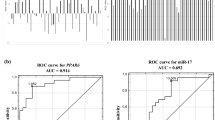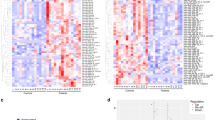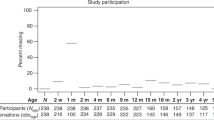Abstract
Background
Peroxisomal proliferator-activated receptors (PPARs) and microRNAs (miRNAs) play important roles in the development of fetuses, whereas expression changes of PPARs and three miRNAs (miR-17, miR-27b and miR-34a) and whether these miRNAs regulate PPARs in non-GDM macrosomia placenta is unclear.
Methods
A case–control study was performed to collect information and placental tissues on mothers and newborns of non-GDM macrosomia and normal-birth-weight infants. In vitro HTR8-SVneo cellular model was used to detect the effects of miRNAs on PPARs expression. Quantitative real-time PCR (qRT-PCR) and western blot was applied to examine the expression levels of PPARs, miR-17, miR-27b, and miR-34a in placental tissues and cells.
Results
The PPARα/γ mRNA and protein levels were significantly up-regulated and miR-27b was down-regulated in the placenta of macrosomia group compared with in the control group, while no difference was observed in PPARβ, miR-17, and miR-34a. After adjusting for confounding factors, low miR-27b and high PPARα/γ mRNA expression still increased the risk of macrosomia. The PPARα/γ protein levels presented a corresponding decrease or increase when cells were transfected with miR-27b mimic or inhibitor.
Conclusions
Placental PPARα/γ and miR-27b expression were associated with non-GDM macrosomia and miR-27b probably promotes the occurrence of non-GDM macrosomia by regulating PPARα/γ protein.
Impact
-
Low miR-27b and high PPARα/γ mRNA expression in the placenta were associated with higher risk of macrosomia.
-
In vitro HTR8-SVneo cell experiment supported that miR-27b could negatively regulate the expression of PPARα and PPARγ protein.
-
MiR-27b was probably involved in non-GDM macrosomia through negative regulation of PPARα/γ protein.
Similar content being viewed by others
Log in or create a free account to read this content
Gain free access to this article, as well as selected content from this journal and more on nature.com
or
Data availability
The datasets generated and analyzed during the current study are available from the corresponding author on reasonable request.
References
Ye, J. et al. Searching for the definition of macrosomia through an outcome-based approach in low- and middle-income countries: a secondary analysis of the WHO Global Survey in Africa, Asia and Latin America. BMC Pregnancy Childbirth 15, 324 (2015).
Koyanagi, A. et al. Macrosomia in 23 developing countries: an analysis of a multicountry, facility-based, cross-sectional survey. Lancet 381, 476–483 (2013).
Zhao, L. J., Li, H. T., Zhang, Y. L., Zhou, Y. B. & Liu, J. M. Mobile terminal-based survey on the birth characteristic for Chinese newborns. J. Peking Univ. (Health Sci.) 51, 813–818 (2019).
Beta, J. et al. Maternal and neonatal complications of fetal macrosomia: systematic review and meta-analysis. Ultrasound Obstet. Gynecol. 54, 308–318 (2019).
Wei, Y. M. & Yang, H. X. Variation of prevalence of macrosomia and cesarean section and its influencing factors. Chin. J. Obstet. Gynecol. 50, 170–176 (2015).
Nijs, H. & Benhalima, K. Gestational diabetes mellitus and the long-term risk for glucose intolerance and overweight in the offspring: a narrative review. J. Clin. Med. 9, 599 (2020).
Liang, H., Zhang, W. Y. & Li, X. T. Reference ranges of gestational weight gain in chinese population on the incidence of macrosomia: a multi-center cross-sectional survey. Chin. J. Obstet. Gynecol 52, 147–152 (2017).
Peng, L. et al. Role of peroxisome proliferator-activated receptors (PPARs) in trophoblast functions. Int. J. Mol. Sci. 22, 433 (2021).
Nakamura, M. T., Yudell, B. E. & Loor, J. J. Regulation of energy metabolism by long-chain fatty acids. Prog. Lipid Res. 53, 124–144 (2014).
Meher, A. P. et al. Placental DHA and mRNA levels of PPARγ and LXRα and their relationship to birth weight. J. Clin. Lipidol. 10, 767–774 (2016).
Chen, S. G. PPARγ Involved in the Regulation of Amino Acid Transporters in Human Placental Syncytiotrophoblasts and Its Mechanism (Second Military Medical University, 2014).
WANG, C. C. et al. Correlation between FAT/CD36 expression in placenta and macrosomia. J. Wenzhou Med. Univ. 47, 416–420 (2017).
Han, Y. et al. Association between the expression level of placental plasma membrane fatty acid binding protein and non-gestational diabetes mellitus macrosomia. J. Wenzhou Med. Univ. 49, 517–522 (2019).
Ni, L.-F. et al. Relationships between placental lipid activated/transport-related factors and macrosomia in healthy pregnancy. Reprod. Sci. 29, 904–914 (2021).
Correia de Sousa, M., Gjorgjieva, M., Dolicka, D., Sobolewski, C. & Foti, M. Deciphering miRNAs’ action through miRNA editing. Int. J. Mol. Sci. 20, 6249 (2019).
Wang, J. M. et al. IRE1α prevents hepatic steatosis by processing and promoting the degradation of select microRNAs. Sci. Signal. 11, eaao4617 (2018).
Du, W. W. et al. Inhibition of dexamethasone-induced fatty liver development by reducing miR-17-5p levels. Mol. Ther. 23, 1222–1233 (2015).
Seenprachawong, K. et al. miR-130a and miR-27b enhance osteogenesis in human bone marrow mesenchymal stem cells via specific down-regulation of peroxisome proliferator-activated receptor γ. Front. Genet. 9, 543 (2018).
Li, J. et al. The role, mechanism and potentially novel biomarker of microRNA-17-92 cluster in macrosomia. Sci. Rep. 5, 17212 (2015).
Ge, Q. et al. Differential expression of circulating miRNAs in maternal plasma in pregnancies with fetal macrosomia. Int. J. Mol. Med. 35, 81–91 (2015).
Kida, K. et al. PPARα is regulated by miR-21 and miR-27b in human liver. Pharm. Res. 28, 2467–2476 (2011).
Sundrani, D. P., Karkhanis, A. R. & Joshi, S. R. Peroxisome proliferator-activated receptors (PPAR), fatty acids and microRNAs: implications in women delivering low birth weight babies. Syst. Biol. Reprod. Med. 67, 24–41 (2021).
Fu, L. et al. Association among placental 11β-HSD2, PPAR-γ, and NF-κB p65 in small-for-gestational-age infants: a nested case-control study. Am. J. Reprod. Immunol. 83, e13231 (2020).
Tagliaferri, S. et al. miR-16-5p, miR-103-3p, and miR-27b-3p as early peripheral biomarkers of fetal growth restriction. Front. Pediatr. 9, 611112 (2021).
Acknowledgements
The authors are thankful to the participants for cooperation and medical staff for their work on information collection.
Funding
This work was funded by Zhejiang Public Welfare Technology Research Program/Social Development (project no.LGF20H260012) and Zhejiang Medical and Health Project (2018KY121).
Author information
Authors and Affiliations
Contributions
X.-J.Y. conceived and designed the study. L.-F.N. conducted experiments and drafted the manuscript. Y.H. conducted experiments and collected the data. Y.-H.W. collected the placenta tissue samples. S.-S.W. and X.-J.L. collected the data and conducted the statistical analyses. H.-T.Y. critically revised the manuscript.
Corresponding author
Ethics declarations
Competing interests
The authors declare no competing interests.
Ethics approval and consent to participate
Informed consent was obtained from all participants included in the study.
Additional information
Publisher’s note Springer Nature remains neutral with regard to jurisdictional claims in published maps and institutional affiliations.
Rights and permissions
About this article
Cite this article
Ni, LF., Han, Y., Wang, SS. et al. Association of placental PPARα/γ and miR-27b expression with macrosomia in healthy pregnancy. Pediatr Res 93, 267–273 (2023). https://doi.org/10.1038/s41390-022-02072-1
Received:
Revised:
Accepted:
Published:
Issue date:
DOI: https://doi.org/10.1038/s41390-022-02072-1



